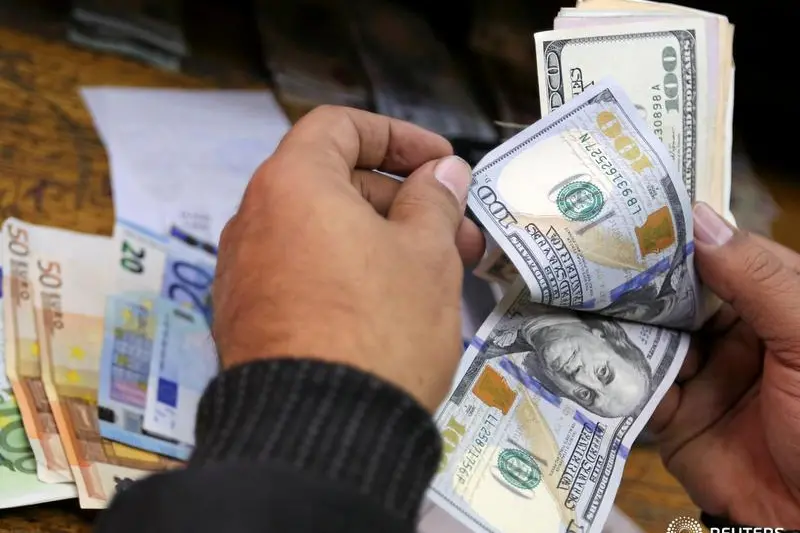PHOTO
The current free fall cycle of the Indian rupee is expected to continue unabated for a while, and currency experts predict that it might test 69.65 to 70 against the dollar in the coming weeks (19 against the UAE dirham).
The relentless slide of the rupee, which declined 30 paise to hit a fresh 16-month low of 68.34 per dollar or 18.63 against the dirham on Wednesday, caused jitters among businesses and investors in India. However, it is good news for non-resident money remitters across the Gulf as they gain more in exchange rate.
"For instance, with today's fall of the rupee by 8.1 paise against the dirham, an NRI remitting home Dh1,000 gets Rs81 more. If, as predicted by currency experts, rupee plunges to 70 against the US dollar or 19.12 against the dirham, the windfall will be substantial," said a money exchange dealer.
Promoth Manghat, executive director of Finablr and CEO of UAE Exchange Group, said the Indian currency has been fluctuating for the past few weeks and plummeted to its lowest since February 2017.
"This depreciation, particularly during the Holy Month of Ramadan, has resulted in a substantial increase in remittances to India. Looking at the pattern, we see anywhere around eight to 10 per cent increase in remittances whenever there is a depreciation of the Indian rupee."
Adeeb Ahamed, MD, LuLu Financial Group, said since the rupee closed at 18.63 against the dirham on Wednesday, it could move between 18.75 and 18.80 within the next few days.
"The rupee continues to slide on account of rising oil prices and the general bearish movement of the equity markets. All currencies, including the euro and pound, have also weakened in this context," said Ahamed.
Sudhesh Giriyan, COO, Xpress Money, said there is invariably an increase in remittances to India whenever the rupee weakens. "This trend can be largely attributed to the white-collar segment as they tend to send more money whenever the exchange rates are favourable. For the white-collar segment, the money sent back home is not time-bound, therefore they prefer to keep an eye on the exchange rates and remit larger amounts every two to three months. The remittance behaviour of the blue-collar segment is completely different as they remit money to their families to provide for their day-to-day expenses. Therefore, those remittances are not impacted by currency fluctuations as they have to send money every month for their basic family needs."
Pradeep Unni, head of strategic business development, Richcomm Global Services, however, believes that the rupee could weaken much faster towards 69.65 to 70 to a dollar, unless the central government and the RBI do not take strong measures to curb the slide.
"Indian rupee is down more than six per cent so far this year. The dollar continues to be adamantly strong and that combined with high oil prices has raised the concerns of wider current account deficit," said Unni.
Financial analysts said a widening fiscal deficit and untamable inflation are behind the fall in the rupee.
"With India running a large current account deficit, it needs a constant inflow of dollars, which was not there. High oil prices inflated the import bill and resulted in further widening of the current account deficit, which speeded up the current cycle of rupee fall," said James Mathews, Group CEO of Crowe Horwath, UAE and Oman.
"Surprise political developments in key Indian states and the fear of the ruling coalition possibly losing its majority in the 2019 general elections had panicked the stock markets too. Since the start of April, foreign investors have sold $1.63 billion and $4.22 billion in local equity and debt market, respectively," said Unni.
Reports suggest that RBI has spent over $8.5 billion of reserves in the four weeks through May 11 to halt the rupee's drop, but the result has been negative so far. "A weaker rupee and higher oil prices will cause inflation to accelerate, which may prompt the Reserve Bank of India to hike interest rates earlier than expected," said Unni.
According to currency experts, multiple econometric analysis points out that every $10 rise in oil prices worsens India's current-account balance by 0.45 per cent of GDP, pushes up inflation by 40-45 basis points, and hurts growth by about 15 -20 basis points.
"During such periods of heightened volatility and uncertainty, investors and traders should use these current trading levels to hedge/trade the Indian rupee futures and options on the Dubai Gold & Commodities Exchange. Investors have the option to hedge up to six to eight months forward," they advised.
Copyright © 2018 Khaleej Times. All Rights Reserved. Provided by SyndiGate Media Inc. (Syndigate.info).












